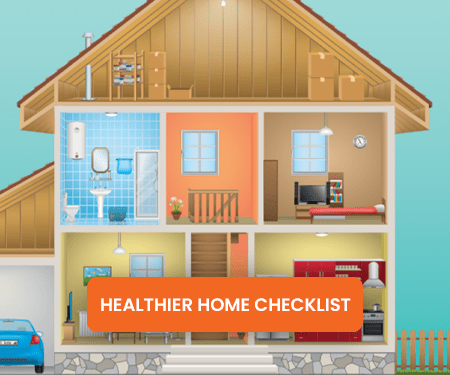Asthma
Allergens and Allergic Asthma
Many people with asthma also have allergies. In fact, allergens are the most common asthma trigger. This is called allergic asthma. It is the most common type of asthma. Allergic asthma is most common in early childhood and steadily decreases through adulthood.
What Is an Allergen?
Allergens are substances that cause an allergic reaction. Allergens can enter the body by being breathed in, swallowed, touched, or injected. They cause an allergic reaction because your body thinks they are harmful. Your immune system responds by releasing an antibody called immunoglobulin E (or IgE). Too much IgE can cause inflammation (swelling) of the airways in your lungs. This can make it harder for you to breathe and can trigger an asthma flare-up or attack. A similar process happens in the nose and sinus areas with allergic rhinitis (also called “hay fever”).
What Are Allergic Asthma Symptoms?
Having allergic asthma means allergens trigger your asthma symptoms. The common signs and symptoms of allergic asthma are the same as other types of asthma:
- Shortness of breath
- Cough
- Chest tightness or pain
- Wheeze (a whistling sound when you breathe)
- Waking at night due to asthma symptoms
- A drop in your peak flow meter reading (if you use one)
- Trouble doing physical activities
Plus, you will also have allergy symptoms, such as red and itchy eyes, sneezing, stuffy nose, and itchy, runny nose.
How Do I Know If I Have Allergic Asthma?
Your doctor will talk with you about your medical and family history. They will give you an exam and run tests to tell if you have allergic asthma. They may do lung function tests. They may also do allergy testing that can include skin and/or blood tests. These tests will help find out if seasonal allergies or year-round allergies may be triggering your asthma.
Examples of seasonal allergies include pollen from trees, grasses, and weeds. Examples of year-round allergies include animal dander, dust mites, and mold.
If you think you have allergic asthma, see a board-certified allergist.
What Is the Treatment for Allergic Asthma?
You can manage your asthma symptoms by treating both your allergies and your asthma.
Asthma medicines: Your doctor may prescribe an asthma control medicine and a quick-relief medicine. These can come as separate medicines or be combined. Inhalers are devices that deliver medicines you breathe in to your lungs. Some people use a different device (nebulizer) for their asthma medicines. A type of medicine called a biologic is given by injection.
Allergy medicines: Many allergy medicines are available without a prescription. They include nasal corticosteroid sprays, antihistamines, and decongestants.
Nasal rinse: Using a saline (saltwater) nose rinse can help cut down mucus and rinse allergens out of your nose. Remember to use these as directed.
Allergy immunotherapy: Some people may benefit from a treatment that trains your body to tolerate allergens better over time. Your allergist may recommend allergy shots or allergy tablets that dissolve under your tongue. These therapies can provide more long-term control of your allergic asthma. It can take 3 to 5 years to successfully complete a course of this treatment.
Manage your allergen exposure: Once you know what you are allergic to, you can take steps to limit your exposure to those substances. This is known as environmental control.
Asthma Action Plan: In addition to treating and managing your asthma and allergies, you’ll also need to follow an Asthma Action Plan. Everyone with asthma needs one. It is a plan created by you and your doctor that gives information and instructions on when and how to treat your asthma.
If you don’t have an Asthma Action Plan, work with your doctor to fill one out.
What Are Common Allergens that Trigger Allergic Asthma Symptoms?
Reducing your exposure to your allergens is an important part of managing your allergic asthma. Here are some of the most common allergens that trigger asthma:
Dust mites: These spider-like creatures are too small to see with the naked eye. They feed on human skin flakes. Both the body parts and feces of dust mites trigger allergies. Dust mites live in warm, moist areas. They are found in places such as beds, pillows, carpets, furniture, clothes, stuffed toys, and fabric.
Mold: Mold can grow on almost anything when moisture is present. Outdoors, many molds live in soil or on leaves, wood, and other plant debris. Indoors, they can be found in a damp basement, near a leaky faucet or pipe, or a wet shower stall or bathtub. Molds produce tiny spores, which are like seeds, to reproduce. These spores become airborne easily. When you breathe in mold spores, it can trigger asthma and allergies.
Animals: Urine, feces, saliva, hair, or dander (skin flakes) from animals − such as cats, dogs, mice, rats, and birds − are all allergens. Animal allergens are everywhere. They can even be found in homes without pets.
Pollen: Pollen from trees, grasses, and weeds is a very common allergen. These airborne particles can travel hundreds of miles. Pollens peak during different seasons of the year. Due to climate change, pollen seasons are getting longer and stronger.
Cockroaches: Cockroaches live all over the world from tropical areas to the coldest spots on earth. Studies show most urban homes have cockroaches. The feces, saliva, and body parts of these insects are believed to be allergens.
Medical Review: July 2024 by John James, MD














